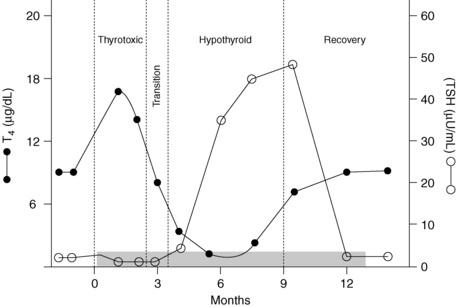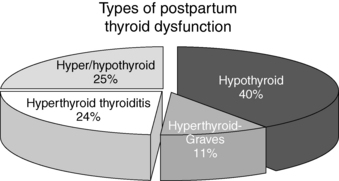Thyroiditis
1. Give the differential diagnosis for thyroiditis.
 Infectious: acute (suppurative), subacute (granulomatous, de Quervain’s)
Infectious: acute (suppurative), subacute (granulomatous, de Quervain’s)
 Autoimmune: chronic lymphocytic (Hashimoto’s disease), atrophic (primary myxedema), juvenile, postpartum
Autoimmune: chronic lymphocytic (Hashimoto’s disease), atrophic (primary myxedema), juvenile, postpartum
 Drug-induced (certain medications, iodinated contrast material)
Drug-induced (certain medications, iodinated contrast material)
2. What causes acute thyroiditis?
This rare disease has an infectious etiology, most reported pathogens being Staphylococcus, Streptococcus, Pneumocystis carinii, and Mycobacterium species. Fungal, parasitic, or syphilitic infections have been reported, and immunocompromised patients may be at increased risk. Patients may demonstrate hypothyroid or hyperthyroid symptoms or may remain euthyroid. Rarely, metastatic disease to the thyroid gland can manifest as acute thyroiditis.
3. How is acute thyroiditis managed?
Treatment involves incision and drainage of the abscess or surgical excision and antimicrobials. Children often have a pyriform sinus fistula, which should be surgically repaired.
4. Describe the four stages of subacute thyroiditis.
 Stage I: Patients have a painful (unilateral or bilateral) tender thyroid and may have systemic symptoms (fatigue, malaise, fever). Inflammatory destruction of thyroid follicles permits release of thyroxine (T4) and triiodothyronine (T3) into the blood, and thyrotoxicosis may ensue.
Stage I: Patients have a painful (unilateral or bilateral) tender thyroid and may have systemic symptoms (fatigue, malaise, fever). Inflammatory destruction of thyroid follicles permits release of thyroxine (T4) and triiodothyronine (T3) into the blood, and thyrotoxicosis may ensue.
 Stage II: A transitory period (several weeks) of euthyroidism occurs after the T4 is cleared from the body.
Stage II: A transitory period (several weeks) of euthyroidism occurs after the T4 is cleared from the body.
 Stage III: With severe disease, patients may become hypothyroid until the thyroid gland repairs itself.
Stage III: With severe disease, patients may become hypothyroid until the thyroid gland repairs itself.
5. Summarize the natural history of subacute thyroiditis.
Subacute thyroiditis is probably viral in origin. Histologically, the inflammation is granulomatous. Although patients almost always recover clinically, serum thyroglobulin (Tgb) levels remain elevated, and intrathyroidal iodine content is low for many months (Fig. 35-1). Such findings suggest persistent subclinical abnormalities after an episode of subacute thyroiditis. Nonsteroidal antiinflammatory agents are first-line treatment in mild to moderate cases, whereas steroids may be needed when the condition is more severe. Patients requiring steroids are more likely to become hypothyroid at a later time. Up to 4% of patients have a second episode many years later.
6. What is the most common cause of thyroiditis?
Autoimmune thyroid disease, which is recognized by the presence of thyroid peroxidase (TPO) antibody and, less frequently, thyroglobulin antibody in serum.
7. Describe the clinical characteristics of autoimmune thyroid disease.
Chronic lymphocytic thyroiditis (Hashimoto’s disease) usually manifests as a euthyroid goiter that progresses to hypothyroidism in middle-aged and older persons, especially women. Atrophic thyroiditis is characterized by a very small thyroid gland in a hypothyroid patient. Some evidence suggests that thyroid growth–inhibitory antibodies may account for the lack of a goiter. Two thirds of adolescents with goiter have autoimmune (juvenile) thyroiditis.
8. Does postpartum thyroiditis follow a different clinical course from that of other types of autoimmune thyroiditis?
Yes. Postpartum disease develops in women between the third and ninth months after delivery, sometimes even 1 year postpartum. It typically follows the stages seen in patients with subacute thyroiditis, although histologically, patients with postpartum disease have lymphocytic infiltration.
9. How common is postpartum thyroiditis?
After delivery, 5% to 10% of women show biochemical evidence of thyroid dysfunction. Approximately one third of affected women have symptoms (either hyperthyroidism, hypothyroidism, or both) and benefit from 6 to 12 months of therapy with levothyroxine (LT4) if they are hypothyroid. Up to 70% of patients experience recurrence with subsequent pregnancies. The frequency of each clinical presentation is depicted in Figure 35-2.
10. Which patients with postpartum thyroiditis should be treated?









